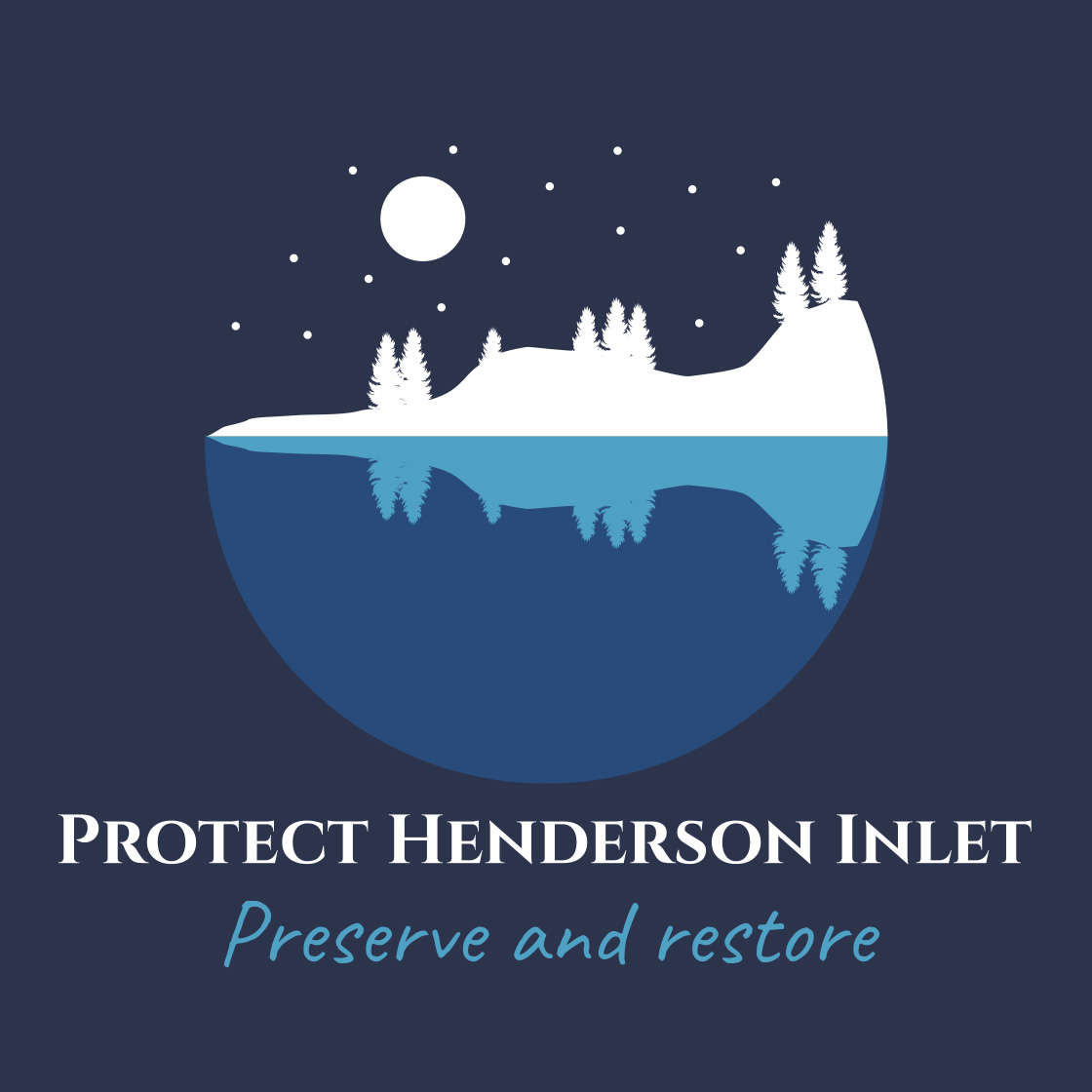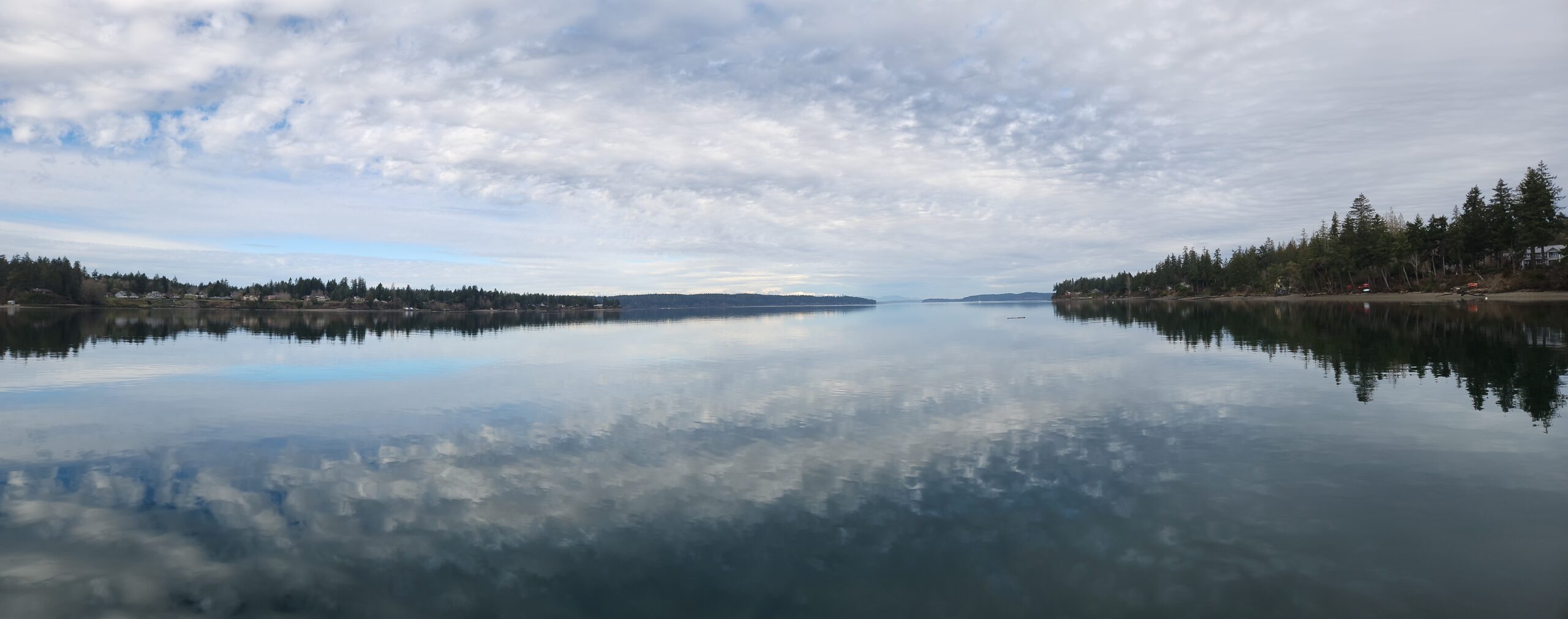Introduction
The pristine beaches and waters of Henderson Inlet are being threatened as never before by a bold attempt by Taylor Shellfish to extend commercial shellfish aquaculture. While there is a long history of small-scale shellfish cultivation in Henderson Inlet with oyster sites intermittently operating mostly in the south and west inlet, there have been no large-scale operations along the Johnson Point coastline of the inlet. There are small, existing geoduck sites on the west shore.
There is a history of native peoples cultivating oysters throughout the Northwest for thousands of years, and PHI recognizes the rights of indigenous peoples to cultivate shellfish. Many non-native residents also grow small quantities of oysters for personal consumption, and there is a generally favorable opinion about small oyster operations in the inlet. In fact, local residents have been contributing significant capital towards making the inlet’s waters suitable for shellfish. Read about the special taxation district that Henderson Inlet occupies designed to improve the water quality of the Inlet, largely developed to satisfy the needs of the oyster producers. Industry receives benefits from this taxation, but does not contribute to this tax base. The Inlet is still subject to harvest closures because of water quality issues related to watershed runoff from Woodland Creek and Woodard Creek as well as the rural county including residential development around Henderson.
PHI is concerned about the use of plastics in the cultivation of all seafood. In the case of oysters, we are watching the development of non-plastic options and will report when alternatives to plastic grow bags become practical. https://projects.sare.org/sare_project/fne21-988/
Geoduck cultivation (distinct from wild geoduck harvest) has only been recently developed, the oldest geoduck sites now less than 20 years old. While PHI understands the tradition of aquaculture in the Salish Sea, the new methodology of geoduck cultivation as practiced by Taylor Shellfish violates basic principles of conservationism, and despite what industry says, is not supported by science. PHI opposes the proposed Taylor permit based on the way that geoduck would be grown, as is detailed further here.
Why we are concerned
In early November 2022, residents of the southwest portion of Johnson Point Loop and at the nearby north end of Otis Beach Street received a somewhat cryptic mailing from the Thurston County Development office, informing these few addresses of a permit application for a commercial shellfish project adjoining their properties. This would be the first such project along the eastern shoreline of Henderson Inlet. It was mid-November before the news of this project began to trickle out to the adjoining neighborhood, but it was alarming to the residents, who had no prior experience with commercial development of tidelands.
There was a great deal of uncertainty about exactly what the project entailed and exactly where it was, because the county’s mailing omitted the last two pages of the notification including instructions for online access to the appropriate maps and permit application. In spite of multiple calls, emails, and visits to the county, it was midway into the comment period before these facts were understood, even though the County had known about the application for several months. Multiple requests for an extension of the December 5th comment deadline went unanswered and requests to the Thurston County Board of Commissioners to intervene produced no action.
In spite of being faced with an overwhelming amount of information to digest about what was being proposed for the tidelands of our inlet, a significant response was made with comment letters filed by many citizens protesting and opposing the permit. A non-profit group was formed and is called Protect Henderson Inlet (PHI). Although the larger mission of working to support the environmental health of Henderson Inlet and the entire Salish Sea through education of the public is important, this group actively opposes intrusive commercial aquaculture.
Documents related to the permit as well as comments from citizens may be viewed here:
https://weblink.co.thurston.wa.us/dspublic
The project number is 2022103702
The project involves a former Bush Tidelands bought by Kyle Mazanti of Colorado in 2017 and leased to Taylor Shellfish in 2018. Most of us had no idea what the Bush/Callow Act of 1895 even was, much less how it could affect us.
Taylor Shellfish proposes to plant a combination of geoduck, manila clams and oysters on this stretch of 8.8 acres of tideland adjoining Johnson Point Loop between tidal ranges of approximately -4.5ft and +10ft relative to MLLW (mean lower low water is considered 0 tide on our commonly used tide charts). They intend to plant 3.6 acres in geoduck which will involve inserting approximately 162,000 plastic tubes (45,000 tubes per acre is what Taylor typically uses) into the beach with 3-4 young clams per tube. The tubes are left for two years then removed. After a total of 5-7 years, the clams are harvested by inserting a hydraulic wand into the beach and liquifying the beach soils to extract the clams. Geoduck are known to extend into the beach substrate by as much as 3 feet. Because of the close spacing of the clams, the result is that there is complete disruption of that section of beach with potential for affecting adjoining beach from suspended sediments. While small scientific studies suggest that beaches can recover from this insult, the cycle of plant and harvest would result in permanent changes.
These photos show examples of geoduck plantations in the South Puget Sound courtesy of Protect Zangle Cove and The Coalition to Protect Puget Sound Habitat.
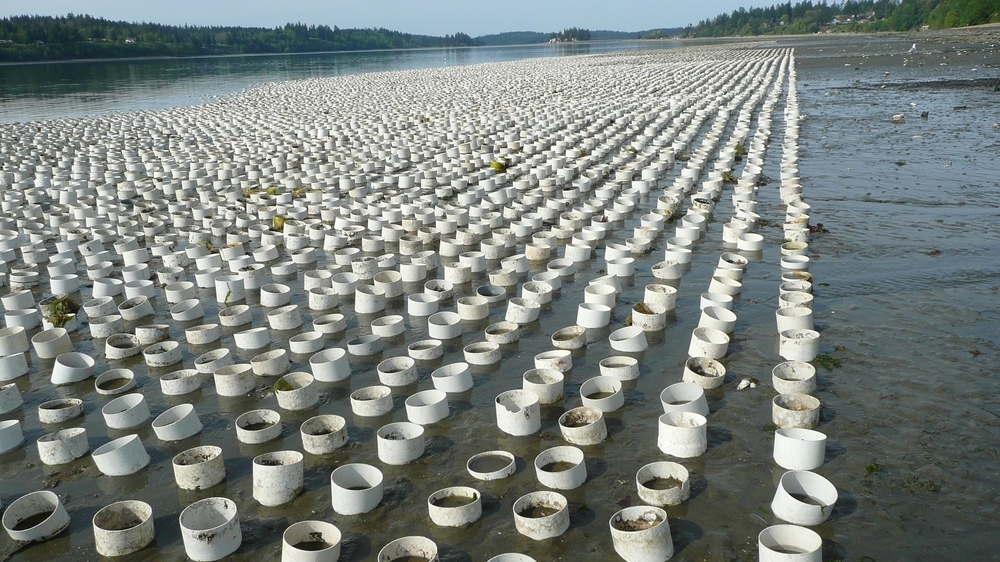
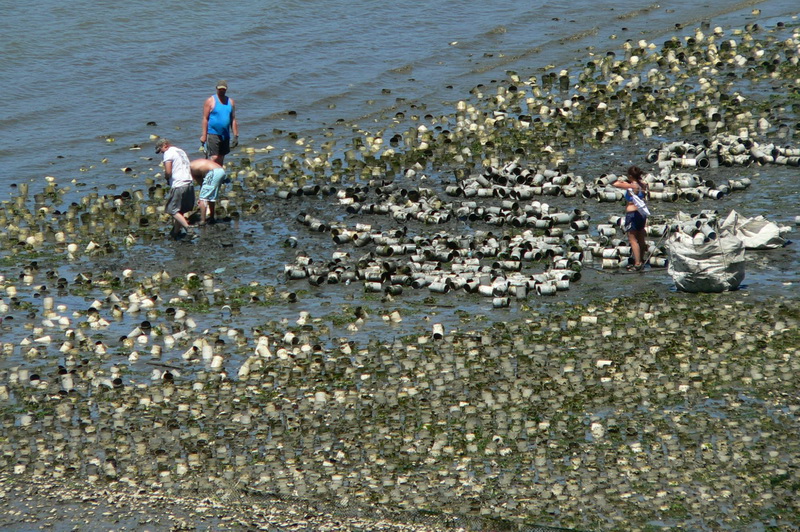
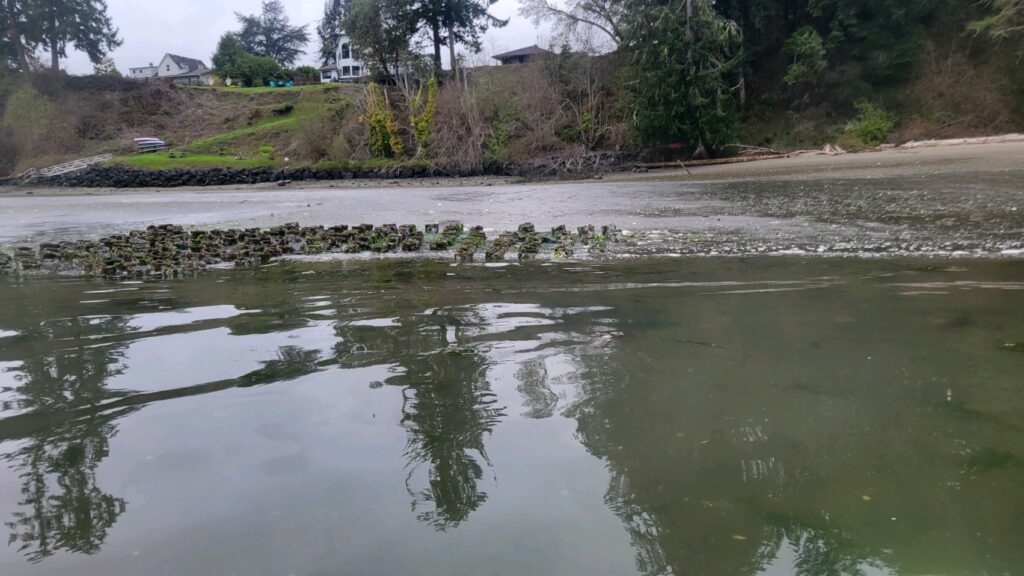
The oyster-growing sections of the project would involve covering the beach with EPDM plastic mesh bags, which would effectively completely block access to the water at tides below 11 feet. While oysters can be grown outside of bags, this stretch of beach is open to Dana Passage to the west for a fetch of 4.5 nautical miles, open to Case Inlet to the north for 10+ miles, and is very dynamic. We feel that there is a very high risk of major loss of plastic debris to the environment particularly with regard to geoduck tubes with potentially disastrous results. Residents of this beach know that loose oysters are quickly dispersed by wave action, and growing outside of bags will not likely be successful. Therefore, beach access is likely to be permanently blocked.
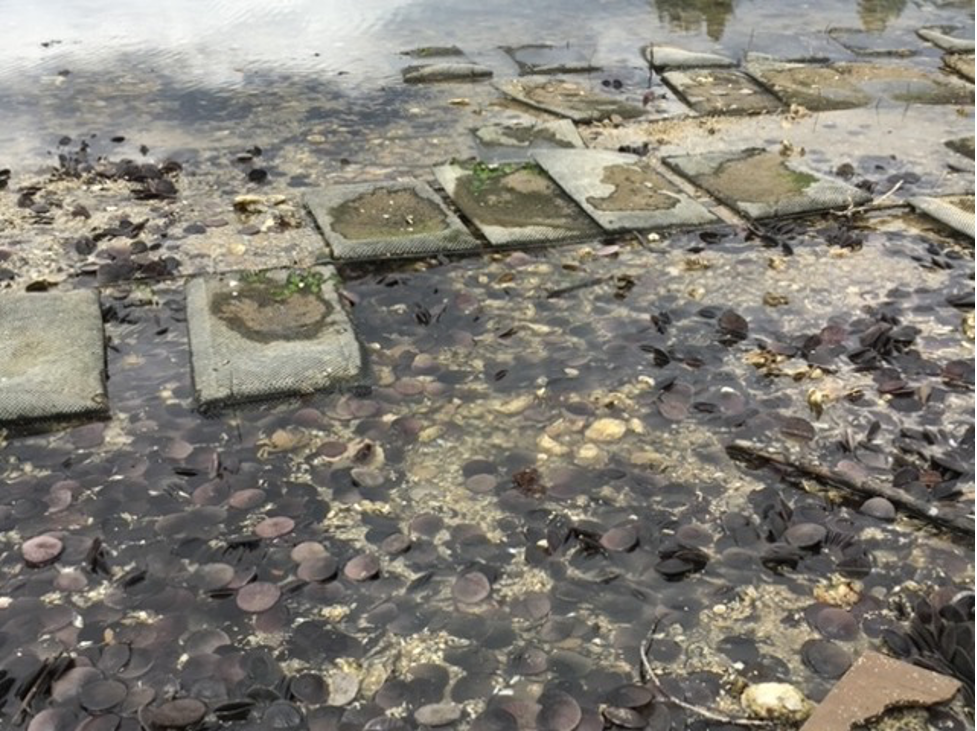
Why are they doing it?
Although Taylor doesn’t share any financial information, using data from public auctions of wild harvested geoduck by the Department of Natural resources and with the expectation of 2 survivors per tube of 2 lbs each, we estimated that the sales value of just the geoduck from this beach is somewhere between 4 and 6 million dollars. The actual value may be much higher. The consumers of these clams are almost exclusively in the Asian market, mostly Chinese, where it is a specialty item that can sell for hundreds of dollars a pound. As such, it is a luxury commodity and is not important as a significant food source. Taxes paid on tidelands are minimal. Beachworkers are generally paid minimum wage. Thus, the motivation for Taylor to grow geoduck is clearly monetary. This is not “feeding the population.” However, Taylor will sell you a geoduck for $60.
https://buy.taylorshellfishfarms.com/clams-mussels-geoduck/geoduck
How can they do this?
Taylor Shellfish, now an international company, is highly influential in Thurston County with seats on the boards of many organizations including Capital Land Trust, the Estuarium, and prominent donations to others including the Nisqually Land Trust. Justin Taylor was active in developing the Shoreline Master Program,
and Taylor officials continue to influence public officials whenever the SMP is reviewed. To be fair, Taylor does donate to many non-profit groups in the Puget Sound Region. Should this allow them to industrialize our beaches?
Read this letter to the Thurston County Planning Commission from general counsel Dianni Taylor E in November 2020. A critique of the quoted scientific articles which in our opinion are misused can be found under the Science tab.
The interests of the shellfish industry are strongly represented through lobbying efforts and in research funding. Indeed, the annual Shellfish Growers conference at Alderbrook Inn is sponsored by The University of Washington through the Seagrant Program. The methodology for growing geoduck in plastic tubes was developed by the University of Washington and given to the shellfish industry. This provoked controversy due to citizen concern about the invasive techniques, and prompted authorization of the Seagrant Program by the State legislature in 2007 for studying geoduck aquaculture. This was funded through NOAA and has supported UW research. In other words UW scientists created the method which caused controversy, then has continuously benefited from the funding that followed.
Please thank the folks at Protect Zangle Cove for producing this response to the shellfish industry’s arguments promoting industrialization of the waterfront.
Home
Another organization active in the fight against industrialization of the tidelands is Coalition to Protect Puget Sound Habitat.
https://coalitiontoprotectpugetsoundhabitat.org/
Please see their summary in their paper Dispelling the Myths of “The Benefits of Shellfish Aquaculture.”
The coalition has successfully taken on the Shellfish industry by its lawsuits against the Corp of Engineers flawed permitting process, found by a Federal judge to be unlawful and upheld in the 3rd Circuit Court of Appeals, requiring a major revamping of the permit process that was used to allow some 900 tidelands permits to be let in the State of Washington. This is apparently about 1/3 of our total state shoreline!
You may read Judge Lasnik’s scathing rebuke of the Corp and the Court of Appeals sustaining comments.
Shamefully, The Corps has circumvented the court’s decision by reissuing the faulty permits under another system without individual review.
Additional information about the ongoing fight against industrial level aquaculture can be seen at:
http://www.friendsofburleylagoon.org/
The upshot of all of this is that we members of PHI, residents of Puget Sound in Washington on the imperiled planet Earth, oppose this industrialization of tidelands which disrupts our benthic ecosystems and massively infuses our environment with plastic for the sole purpose of monetary gain. While science shows that the beaches of the Salish Sea are robust and resilient, they are not immune to damage, each individual permit producing one more insult, the cumulative effect of which is being considered in no serious scientific study. We encourage those interested in the health of our estuaries to look for the truth about what is causing the declining health of the Puget Sound and speak to your representatives about enacting more protective measures.
You may reach local and state officials here:
Send to Commissioner Franz via email:
[email protected]
[email protected]
206-682-7328
Office of the Commissioner of Public Lands
MS 47001
Olympia, WA 98504-7001
360-902-1000
https://www.dnr.wa.gov/programs-and-services/aquatics
Thurston County Commissioners
https://www.thurstoncountywa.gov/bocc
Contact for entire board
https://www.thurstoncountywa.gov/email/pages/default.aspx?List-ID=45
Carolina Mejia – District 1 which includes Henderson Inlet
https://www.thurstoncountywa.gov/email/pages/default.aspx?List-ID=440
Gary Edwards – District 2 which includes eastern part of the County
https://www.thurstoncountywa.gov/email/pages/default.aspx?List-ID=450
Tye Menser – District 3 which includes western part of the County
https://www.thurstoncountywa.gov/email/pages/default.aspx?List-ID=256
